Petrogenesis and Tectonic Evolution of I- and A-Type Granites of Mount Abu Kibash and Tulayah, Egypt: Evidence for Transition from Subduction to Post-Collision Magmatism
Abstract
:1. Introduction
2. Geologic Features and Petrography
3. Materials and Methods
4. Results
4.1. Mineral Chemistry
4.2. Whole-Rock Geochemistry
5. Discussion
5.1. Granitic Rocks Crystallization Conditions (T, P and fO2)
5.2. Role of Crustal Contamination and Fractional Crystallization
5.3. Magmatic Sources
5.4. Petrogenesis and Geodynamic Evolution
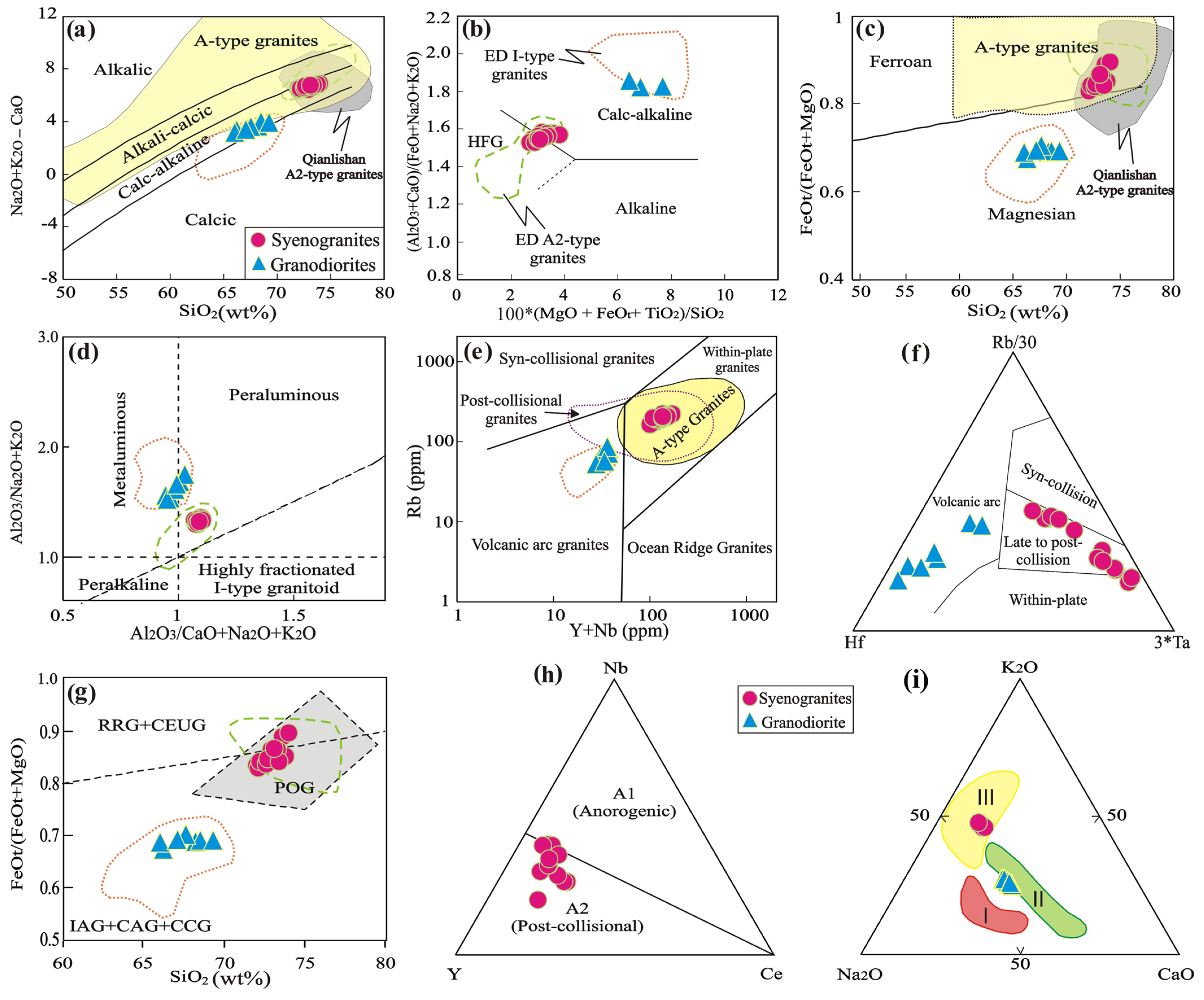
6. Concluding Remarks
- The Mount Abu Kibash and Tulayah area in the central Eastern Desert of Egypt have two different granite phases: I-type (granodiorites) and A2-type (syenogranites). The I-type granites represent the earlier phase that are slightly altered, deformed, and intrude the A2-type granites (later phase) that are fresh and undeformed.
- Granodiorites (I-type) have a crustal-mantle mixed source while syenogranites (A2-type) were generated by partial melting of lower juvenile crustal source (tonalite). Evolution of both types was controlled by simultaneous assimilation and fractional crystallization.
- Both I- and A-type granites were crystallized at low pressure (<3.5 kbar) in the upper continental crust but at average temperatures of 807 °C and 792 °C, respectively. The I-type granites were generated from calc-alkaline, metaluminous magma during a collisional stage (volcanic arc), while the A2-type granites are peraluminous and formed in a post-collisional stage (extensional environment). The syenogranites were formed after crustal thickening and lithospheric delamination that caused upwelling of hot asthenosphere. Underplating of upwelled mafic melts beneath lower crust caused fertilization of the lithosphere by HFSEs and alkalis before partial melting.
- The transition from subduction to post-collisional setting was accompanied by strong magmatic activity and emplacement of large masses of A2-type granites as a result of crustal uplifting, thickening, and extensional collapse of the ANS continental crust that occurred at the end of Pan-African orogenic event.
Supplementary Materials
Author Contributions
Funding
Data Availability Statement
Acknowledgments
Conflicts of Interest
References
- Sami, M.; Adam, M.M.; Lv, X.; Lasheen, E.S.R.; Ene, A.; Zakaly, H.M.; Alarifi, S.S.; Mahdy, N.M.; Abdel Rahman, A.R.A.; Saeed, A. Petrogenesis and Tectonic Implications of the Cryogenian I-Type Granodiorites from Gabgaba Terrane (NE Sudan). Minerals 2023, 13, 331. [Google Scholar] [CrossRef]
- Stern, R.J. Arc assembly and continental collision in the Neoproterozoic East African Orogen: Implications for the consolidation of Gondwanaland. Annu. Rev. Earth Planet. Sci. 1994, 22, 319–351. [Google Scholar] [CrossRef]
- Stoeser, D.B.; Frost, C.D. Nd, Pb, Sr, and O isotopic characterization of Saudi Arabian Shield terranes. Chem. Geol. 2006, 226, 163–188. [Google Scholar] [CrossRef]
- Stern, R.J. Crustal evolution in the East African Orogen: A neodymium isotopic perspective. J. Afr. Earth Sci. 2002, 34, 109–117. [Google Scholar] [CrossRef]
- Sami, M.; El Monsef, M.A.; Abart, R.; Toksoy-Köksal, F.; Abdelfadil, K.M. Unraveling the Genesis of Highly Fractionated Rare-Metal Granites in the Nubian Shield via the Rare-Earth Elements Tetrad Effect, Sr–Nd Isotope Systematics, and Mineral Chemistry. ACS Earth Space Chem. 2022, 6, 2368–2384. [Google Scholar] [CrossRef]
- Gamaleldien, H.; Li, Z.-X.; Anbar, M.A.; Murphy, J.B.; Evans, N.J.; Xia, X.-P. Formation of juvenile continental crust in northern Nubian Shield: New evidence from granitic zircon U-Pb-Hf-O isotopes. Precambrian Res. 2022, 379, 106791. [Google Scholar] [CrossRef]
- Abdel-Karim, A.-A.M.; Ali, S.; El-Awady, A.; Elwan, W. Mineral and bulk–rock chemistry of Shadli bimodal metavolcanics from Eastern Desert of Egypt: Implication for tectonomagmatic setting and Neoproterozoic continental growth in the Arabian–Nubian Shield. Lithos 2019, 338, 204–217. [Google Scholar] [CrossRef]
- Seddik, A.M.A.; Darwish, M.H.; Azer, M.K.; Asimow, P.D. Assessment of magmatic versus post-magmatic processes in the Mueilha rare-metal granite, Eastern Desert of Egypt, Arabian-Nubian Shield. Lithos 2020, 366, 105542. [Google Scholar] [CrossRef]
- Farahat, E.S.; Mohamed, H.A.; Ahmed, A.F.; El Mahallawi, M.M. Origin of I- and A-type granitoids from the eastern desert of Egypt: Implications for crustal growth in the northern Arabian-Nubian Shield. J. Afr. Earth Sci. 2007, 49, 43–58. [Google Scholar] [CrossRef]
- Zoheir, B.; Lehmann, B.; Emam, A.; Radwan, A.; Zhang, R.; Bain, W.M.; Steele-MacInnis, M.; Nolte, N. Extreme fractionation and magmatic–hydrothermal transition in the formation of the Abu Dabbab rare-metal granite, Eastern Desert, Egypt. Lithos 2020, 352, 105329. [Google Scholar] [CrossRef]
- Ali, K.; Andresen, A.; Manton, W.I.; Stern, R.J.; Omar, S.A.; Maurice, A.E. U–Pb zircon dating and Sr–Nd–Hf isotopic evidence to support a juvenile origin of the ~634 Ma El Shalul granitic gneiss dome, Arabian–Nubian Shield. Geol. Mag. 2011, 149, 783–797. [Google Scholar] [CrossRef]
- Stern, R.J.; Khedr, M.Z.; Whitehouse, M.J.; Romer, R.L.; Khashaba, S.M.A.; El-Shibiny, N. Late Cryogenian and early Ediacaran rare-metal rich granites in the Eastern Desert of Egypt: Constraints from zircon ages and whole-rock Sr-and Nd-and feldspar Pb-isotopic compositions. J. Geol. Soc. 2024, 181, jgs2023-068. [Google Scholar] [CrossRef]
- Tischendorf, G.; Gottesmann, B.; Förster, H.-J.; Trumbull, R.B. On Li-bearing micas: Estimating Li from electron microprobe analyses and an improved diagram for graphical representation. Mineral. Mag. 1997, 61, 809–834. [Google Scholar] [CrossRef]
- Nachit, H.; Ibhi, A.; Abia, E.H.; Ben Ohoud, M. Discrimination between primary magmatic biotites, reequilibrated biotites and neoformed biotites. Comptes Rendus Geosci. 2005, 337, 1415–1420. [Google Scholar] [CrossRef]
- Miller, C.F.; Stoddard, E.F.; Bradfish, L.J.; Dollase, W.A. Composition of Plutonic Muscovite: Genetic Implications. Can. Mineral. 1981, 19, 25–34. [Google Scholar]
- Leake, B.E.; Woolley, A.R.; Arps, C.E.S.; Birch, W.D.; Gilbert, M.C.; Grice, J.D.; Hawthorne, F.C.; Kato, A.; Kisch, H.J.; Krivovichev, V.G.; et al. Nomenclature of Amphiboles; Report of the Subcommittee on Amphiboles of the International Mineralogical Association Commission on New Minerals and Mineral Names. Mineral. Mag. 1997, 61, 295–310. [Google Scholar] [CrossRef]
- Girardeau, J.; Mevel, C. Amphibolitized sheared gabbros from ophiolites as indicators of the evolution of the oceanic crust: Bay of Islands, Newfoundland. Earth Planet. Sci. Lett. 1982, 61, 151–165. [Google Scholar] [CrossRef]
- Hassan, M.; Hashad, A. Precambrian of Egypt. In The Geology of Egypt; Balkema: Rotterdam, The Netherlands, 1990; pp. 201–245. [Google Scholar]
- Middlemost, E.A.K. Naming materials in the magma/igneous rock system. Earth-Sci. Rev. 1994, 37, 215–224. [Google Scholar] [CrossRef]
- Barker, F.; Arth, J.G. Generation of trondhjemitic-tonalitic liquids and Archean bimodal trondhjemite-basalt suites. Geology 1976, 4, 596–600. [Google Scholar] [CrossRef]
- Rickwood, P.C. Boundary lines within petrologic diagrams which use oxides of major and minor elements. Lithos 1989, 22, 247–263. [Google Scholar] [CrossRef]
- Rudnick, R.L.; Gao, S. 3.01—Composition of the Continental Crust A2—Holland, Heinrich D. In Treatise on Geochemistry; Turekian, K.K., Ed.; Pergamon: Oxford, UK, 2003; pp. 1–64. [Google Scholar]
- Sun, S.-S.; McDonough, W.F. Chemical and isotopic systematics of oceanic basalts: Implications for mantle composition and processes. Geol. Soc. Lond. Spec. Publ. 1989, 42, 313–345. [Google Scholar] [CrossRef]
- Azer, M.K.; Abdelfadil, K.M.; Asimow, P.D.; Khalil, A.E.; Bozkurt, E. Tracking the transition from subduction-related to post-collisional magmatism in the north Arabian–Nubian Shield: A case study from the Homrit Waggat area of the Eastern Desert of Egypt. Geol. J. 2019, 55, 4426–4452. [Google Scholar] [CrossRef]
- Chen, Y.; Li, H.; Sun, W.; Ireland, T.; Tian, X.; Hu, Y.; Yang, W.; Chen, C.; Xu, D. Generation of Late Mesozoic Qianlishan A2-type granite in Nanling Range, South China: Implications for Shizhuyuan W–Sn mineralization and tectonic evolution. Lithos 2016, 266, 435–452. [Google Scholar] [CrossRef]
- Sami, M.; Ntaflos, T.; Farahat, E.S.; Mohamed, H.A.; Ahmed, A.F.; Hauzenberger, C. Mineralogical, geochemical and Sr-Nd isotopes characteristics of fluorite-bearing granites in the Northern Arabian-Nubian Shield, Egypt: Constraints on petrogenesis and evolution of their associated rare metal mineralization. Ore Geol. Rev. 2017, 88, 1–22. [Google Scholar] [CrossRef]
- Boehnke, P.; Watson, E.B.; Trail, D.; Harrison, T.M.; Schmitt, A.K. Zircon saturation re-revisited. Chem. Geol. 2013, 351, 324–334. [Google Scholar] [CrossRef]
- Fuhrman, M.L.; Lindsley, D.H. Ternary-feldspar modeling and thermometry. Am. Mineral. 1988, 73, 201–215. [Google Scholar]
- Liao, Y.; Wei, C.; Rehman, H.U. Titanium in calcium amphibole: Behavior and thermometry. Am. Mineral. 2021, 106, 180–191. [Google Scholar] [CrossRef]
- Henry, D.J.; Guidotti, C.V.; Thomson, J.A. The Ti-saturation surface for low-to-medium pressure metapelitic biotites: Implications for geothermometry and Ti-substitution mechanisms. Am. Mineral. 2005, 90, 316–328. [Google Scholar] [CrossRef]
- Tuttle, O.F.; Bowen, N.L. Origin of Granite in the Light of Experimental Studies in the System NaAlSi3O8–KAlSi3O8–SiO2–H2O.; Tuttle, O.F., Bowen, N.L., Eds.; Geological Society of America: New York, NY, USA, 1958. [Google Scholar]
- Anderson, J.L.; Barth, A.P.; Wooden, J.L.; Mazdab, F. Thermometers and thermobarometers in granitic systems. Rev. Mineral. Geochem. 2008, 69, 121–142. [Google Scholar] [CrossRef]
- Yang, X.M. Estimation of crystallization pressure of granite intrusions. Lithos 2017, 286, 324–329. [Google Scholar] [CrossRef]
- Anderson, J.L.; Smith, D.R. The effects of temperature and fO₂ on the Al-in-hornblende barometer. Am. Mineral. 1995, 80, 549–559. [Google Scholar] [CrossRef]
- Wones, D.R. Significance of the Assemblage Titanite + Magnetite + Quartz in Granitic-Rocks. Am. Mineral. 1989, 74, 744–749. [Google Scholar]
- Wilke, M.; Behrens, H. The dependence of the partitioning of iron and europium between plagioclase and hydrous tonalitic melt on oxygen fugacity. Contrib. Mineral. Petrol. 1999, 137, 102–114. [Google Scholar] [CrossRef]
- Akinin, V.V.; Miller, E.L.; Wooden, J.L. Petrology and geochronology of crustal xenoliths from the Bering Strait region: Linking deep and shallow processes in extending continental crust. In Crustal Cross Sections from the Western North American Cordillera and Elsewhere: Implications for Tectonic and Petrologic Processes: Geological Society of America Special Paper; Geological Society of America: Boulder, CO, USA, 2009; Volume 456, pp. 39–68. [Google Scholar]
- Xiao, W.; Liu, C.; Tan, K.; Duan, X.; Shi, K.; Sui, Q.; Feng, P.; Sami, M.; Ahmed, M.S.; Zi, F. Two Distinct Fractional Crystallization Mechanisms of A-Type Granites in the Nanling Range, South China: A Case Study of the Jiuyishan Complex Massif and Xianghualing Intrusive Stocks. Minerals 2023, 13, 605. [Google Scholar] [CrossRef]
- Nicolae, I.; Saccani, E. Petrology and geochemistry of the Late Jurassic calc-alkaline series associated to Middle Jurassic ophiolites in the South Apuseni Mountains (Romania). Schweiz. Mineral. Und Petrogr. Mitteilungen 2003, 83, 81–96. [Google Scholar]
- Whalen, J.B.; Currie, K.L.; Chappell, B.W. A-type granites: Geochemical characteristics, discrimination and petrogenesis. Contrib. Mineral. Petrol. 1987, 95, 407–419. [Google Scholar] [CrossRef]
- Laurent, O.; Martin, H.; Moyen, J.F.; Doucelance, R. The diversity and evolution of late-Archean granitoids: Evidence for the onset of “modern-style” plate tectonics between 3.0 and 2.5 Ga. Lithos 2014, 205, 208–235. [Google Scholar] [CrossRef]
- Baker, M.; Hirschmann, M.; Ghiorso, M.; Stolper, E. Compositions of near-solidus peridotite melts from experiments and thermodynamic calculations. Nature 1995, 375, 308–311. [Google Scholar] [CrossRef]
- Sami, M.; Azer, M.; Abdel-Karim, A.-A. Postcollisional Ferani Volcanics from North Arabian–Nubian Shield (South Sinai, Egypt): Petrogenesis and Implication for Ediacaran (607–593 Ma) Geodynamic Evolution. J. Geol. 2022, 130, 475–498. [Google Scholar] [CrossRef]
- Shaw, D. A review of K-Rb fractionation trends by covariance analysis. Geochim. Cosmochim. Acta 1968, 32, 573–601. [Google Scholar] [CrossRef]
- Rudnick, R.L.; Fountain, D.M. Nature and composition of the continental crust: A lower crustal perspective. Rev. Geophys. 1995, 33, 267–309. [Google Scholar] [CrossRef]
- Hofmann, A.W.; Jochum, K.P.; Seufert, M.; White, W.M. Nb and Pb in oceanic basalts: New constraints on mantle evolution. Earth Planet. Sci. Lett. 1986, 79, 33–45. [Google Scholar] [CrossRef]
- Weyer, S.; Münker, C.; Mezger, K. Nb/Ta, Zr/Hf and REE in the depleted mantle: Implications for the differentiation history of the crust–mantle system. Earth Planet. Sci. Lett. 2003, 205, 309–324. [Google Scholar] [CrossRef]
- David, K.; Schiano, P.; Allegre, C. Assessment of the Zr/Hf fractionation in oceanic basalts and continental materials during petrogenetic processes. Earth Planet. Sci. Lett. 2000, 178, 285–301. [Google Scholar] [CrossRef]
- Turner, S.J.; Langmuir, C.H. The global chemical systematics of arc front stratovolcanoes: Evaluating the role of crustal processes. Earth Planet. Sci. Lett. 2015, 422, 182–193. [Google Scholar] [CrossRef]
- Petford, N.; Gallagher, K. Partial melting of mafic (amphibolitic) lower crust by periodic influx of basaltic magma. Earth Planet. Sci. Lett. 2001, 193, 483–499. [Google Scholar] [CrossRef]
- Hora, J.M.; Singer, B.S.; Wörner, G.; Beard, B.L.; Jicha, B.R.; Johnson, C.M. Shallow and deep crustal control on differentiation of calc-alkaline and tholeiitic magma. Earth Planet. Sci. Lett. 2009, 285, 75–86. [Google Scholar] [CrossRef]
- Griffin, W.L.; Wang, X.; Jackson, S.E.; Pearson, N.J.; O’Reilly, S.Y.; Xu, X.; Zhou, X. Zircon chemistry and magma mixing, SE China: In-situ analysis of Hf isotopes, Tonglu and Pingtan igneous complexes. Lithos 2002, 61, 237–269. [Google Scholar] [CrossRef]
- Bonin, B. A-type granites and related rocks: Evolution of a concept, problems and prospects. Lithos 2007, 97, 1–29. [Google Scholar] [CrossRef]
- Sami, M.; Osman, H.; Ahmed, A.F.; Zaky, K.S.; Abart, R.; Sanislav, I.V.; Abdelrahman, K.; Fnais, M.S.; Xiao, W.; Abbas, H. Magmatic Evolution and Rare Metal Mineralization in Mount El-Sibai Peralkaline Granites, Central Eastern Desert, Egypt: Insights from Whole-Rock Geochemistry and Mineral Chemistry Data. Minerals 2023, 13, 1039. [Google Scholar] [CrossRef]
- Wang, L.-X.; Ma, C.-Q.; Zhang, C.; Zhu, Y.-X.; Marks, M.A.W. Halogen geochemistry of I- and A-type granites from Jiuhuashan region (South China): Insights into the elevated fluorine in A-type granite. Chem. Geol. 2018, 478, 164–182. [Google Scholar] [CrossRef]
- Marangoanha, B.; de Oliveira, D.C.; Galarza, M.A.; Marques, G.T. Crustal anatexis and mantle-derived magmas forming Neoarchean A-type granitoids in Carajás Province, northern Brazil: Petrological evidence and tectonic control. Precambrian Res. 2020, 338, 105585. [Google Scholar] [CrossRef]
- Collins, W.J.; Beams, S.D.; White, A.J.R.; Chappell, B.W. Nature and origin of A-type granites with particular reference to southeastern Australia. Contrib. Mineral. Petrol. 1982, 80, 189–200. [Google Scholar] [CrossRef]
- Creaser, R.A.; Price, R.C.; Wormald, R.J. A-type granites revisited: Assessment of a residual-source model. Geology 1991, 19, 163–166. [Google Scholar] [CrossRef]
- King, P.L.; White, A.J.R.; Chappell, B.W.; Allen, C.M. Characterization and origin of aluminous A-type granites from the Lachlan Fold Belt, Southeastern Australia. J. Petrol. 1997, 38, 371–391. [Google Scholar] [CrossRef]
- Eby, G.N. Chemical subdivision of the A-type granitoids:Petrogenetic and tectonic implications. Geology 1992, 20, 641–644. [Google Scholar] [CrossRef]
- Sylvester, P.J. Post-Collisional Alkaline Granites. J. Geol. 1989, 97, 261–280. [Google Scholar] [CrossRef]
- Frost, B.R.; Barnes, C.G.; Collins, W.J.; Arculus, R.J.; Ellis, D.J.; Frost, C.D. A geochemical classification for granitic rocks. J. Petrol. 2001, 42, 2033–2048. [Google Scholar] [CrossRef]
- Liégeois, J.-P.; Navez, J.; Hertogen, J.; Black, R. Contrasting origin of post-collisional high-K calc-alkaline and shoshonitic versus alkaline and peralkaline granitoids. The use of sliding normalization. Lithos 1998, 45, 1–28. [Google Scholar] [CrossRef]
- Chappell, B.W.; White, A.J.R.; Brown, P.E.; Chappell, B.W. I- and S-type granites in the Lachlan Fold Belt. In The Second Hutton Symposium on the Origin of Granites and Related Rocks; Geological Society of America: New York, NY, USA, 1992; Volume 272. [Google Scholar]
- Pearce, J.A. Sources and settings of granitic rocks. Episodes 1996, 19, 120–125. [Google Scholar] [CrossRef]
- Pearce, J.A.; Harris, N.B.; Tindle, A.G. Trace element discrimination diagrams for the tectonic interpretation of granitic rocks. J. Petrol. 1984, 25, 956–983. [Google Scholar] [CrossRef]
- Harris, N.B.W.; Pearce, J.A.; Tindle, A.G. Geochemical characteristics of collision-zone magmatism. Geol. Soc. Lond. Spec. Publ. 1986, 19, 67–81. [Google Scholar] [CrossRef]
- Maniar, P.D.; Piccoli, P.M. Tectonic discrimination of granitoids. Geol. Soc. Am. Bull. 1989, 101, 635–643. [Google Scholar] [CrossRef]
- Eby, G.N. The A-type granitoids: A review of their occurrence and chemical characteristics and speculations on their petrogenesis. Lithos 1990, 26, 115–134. [Google Scholar] [CrossRef]
- Abdel-Rahman, A.F.M. Nature of Biotites from Alkaline, Calc-alkaline, and Peraluminous Magmas. J. Petrol. 1994, 35, 525–541. [Google Scholar] [CrossRef]
- Ridolfi, F.; Renzulli, A.; Puerini, M. Stability and chemical equilibrium of amphibole in calc-alkaline magmas: An overview, new thermobarometric formulations and application to subduction-related volcanoes. Contrib. Mineral. Petrol. 2010, 160, 45–66. [Google Scholar] [CrossRef]
- Jiang, C.; An, S. On chemical characteristics of calcific amphiboles from igneous rocks and their petrogenesis significance. J. Mineral. Petrol. 1984, 3, 1–9. [Google Scholar]
- Coltorti, M.; Bonadiman, C.; Faccini, B.; Grégoire, M.; O’Reilly, S.Y.; Powell, W. Amphiboles from suprasubduction and intraplate lithospheric mantle. Lithos 2007, 99, 68–84. [Google Scholar] [CrossRef]
- El-Dokouny, H.A.; Mahdy, N.M.; El Hadek, H.H.; Sami, M.; Abart, R.; Ahmed, M.S.; Zafar, T.; Sanislav, I.V. Origin of Amphibole-Biotite-Fluorite-Rich Enclaves from Gabal El-Ineigi Fluorite-Bearing Granite, Central Eastern Desert of Egypt: Insights into Fluoride–Calcium and Silicate Liquid Immiscibility. Minerals 2023, 13, 670. [Google Scholar] [CrossRef]
- Johnson, P.R.; Andresen, A.; Collins, A.S.; Fowler, A.R.; Fritz, H.; Ghebreab, W.; Kusky, T.; Stern, R.J. Late Cryogenian–Ediacaran history of the Arabian–Nubian Shield: A review of depositional, plutonic, structural, and tectonic events in the closing stages of the northern East African Orogen. J. Afr. Earth Sci. 2011, 61, 167–232. [Google Scholar] [CrossRef]
- Schott, B.; Schmeling, H. Delamination and detachment of a lithospheric root. Tectonophysics 1998, 296, 225–247. [Google Scholar] [CrossRef]
- Avigad, D.; Gvirtzman, Z. Late Neoproterozoic rise and fall of the northern Arabian–Nubian shield: The role of lithospheric mantle delamination and subsequent thermal subsidence. Tectonophysics 2009, 477, 217–228. [Google Scholar] [CrossRef]
- Martin, R.F. A-type granites of crustal origin ultimately result from open-system fenitization-type reactions in an extensional environment. Lithos 2006, 91, 125–136. [Google Scholar] [CrossRef]
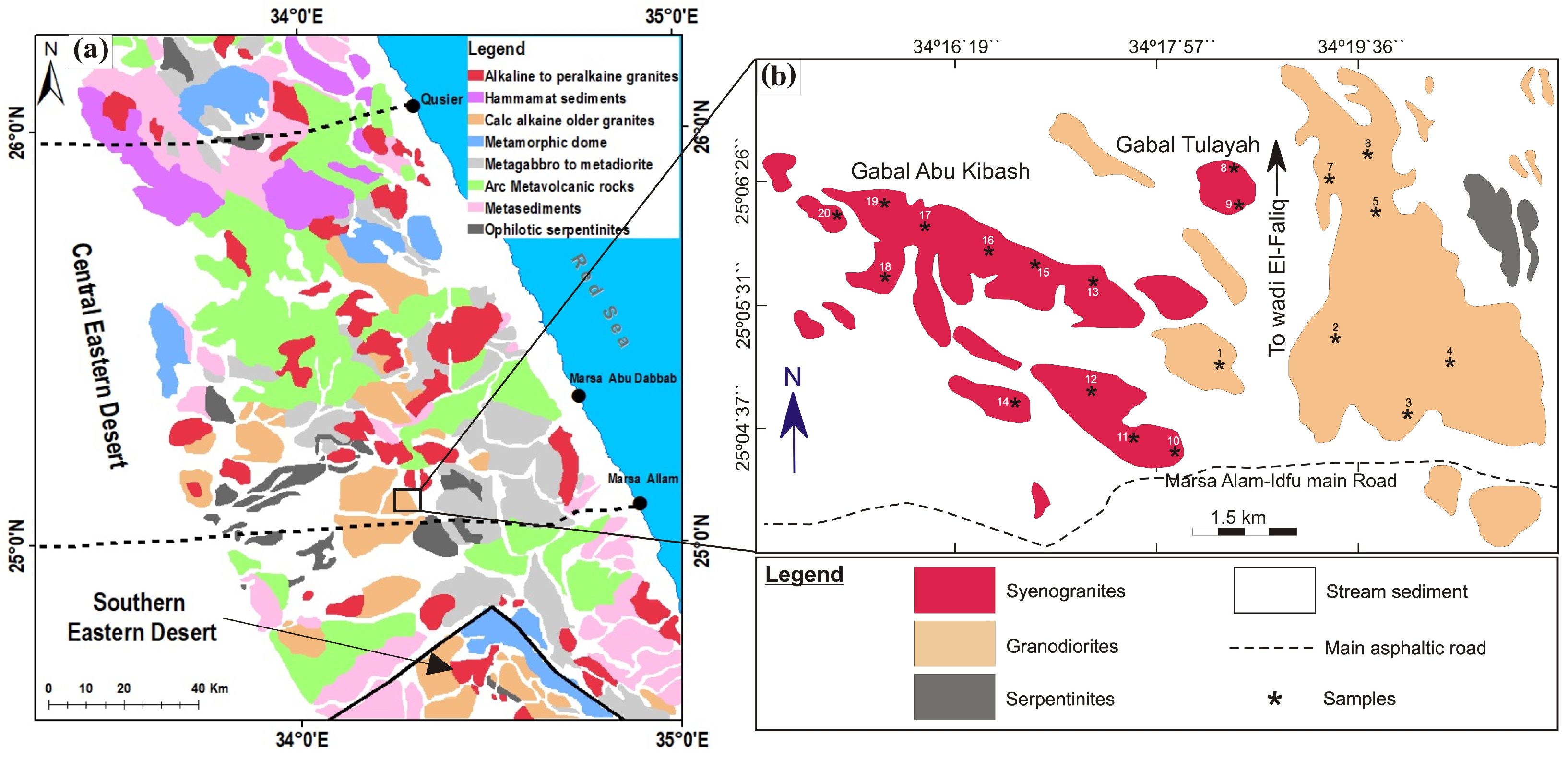
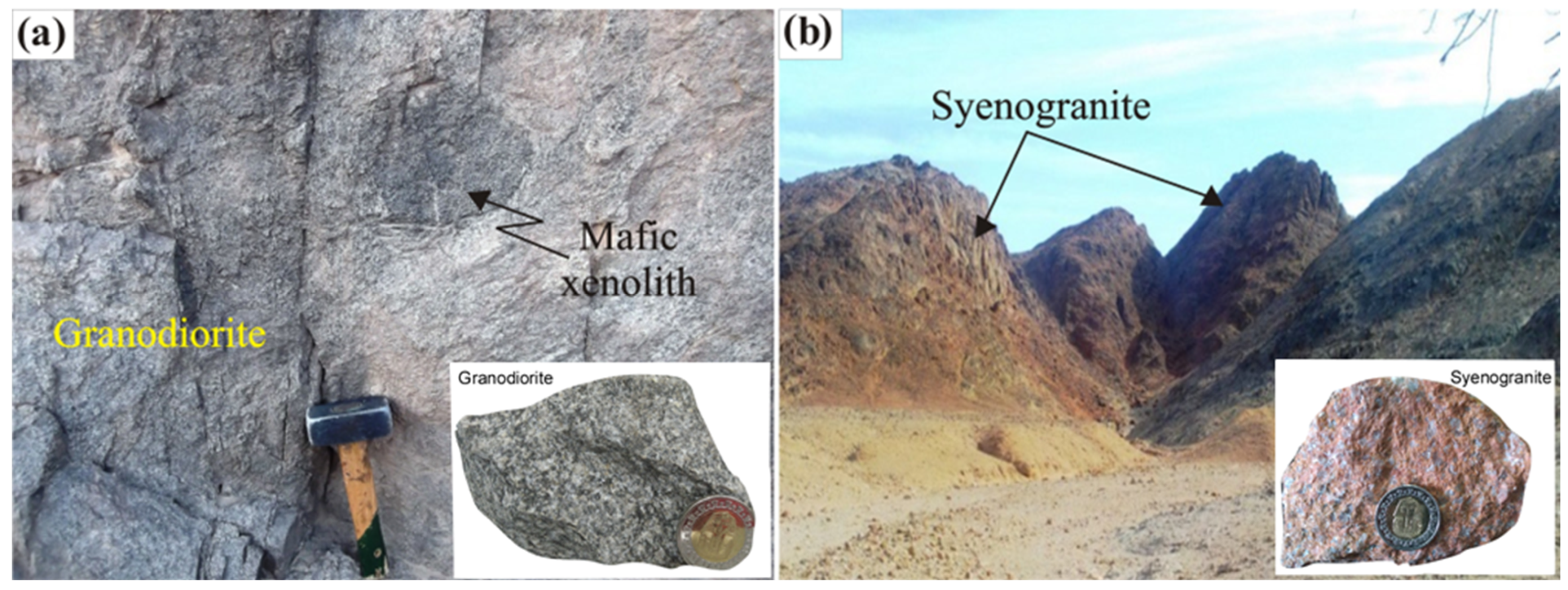
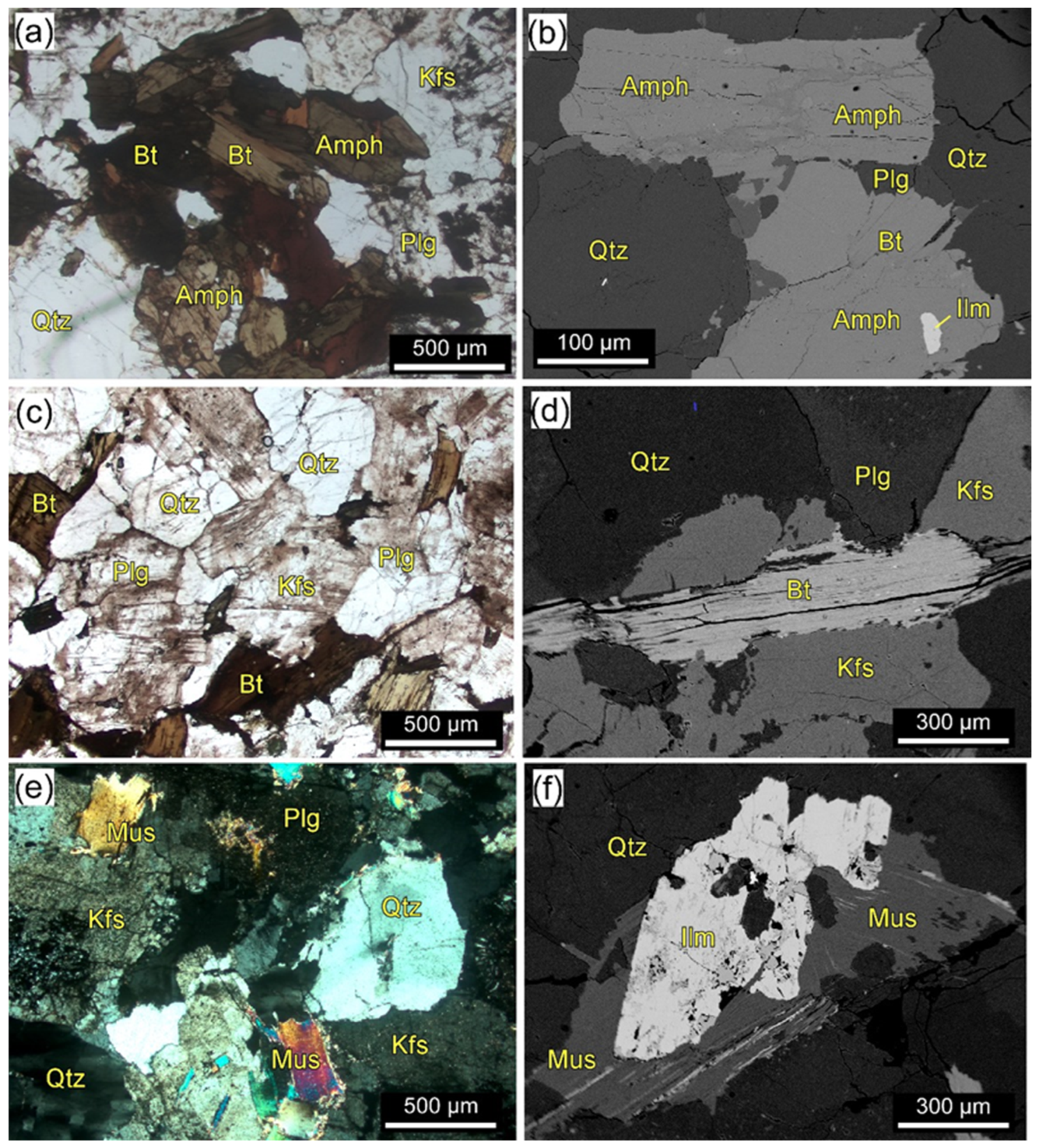
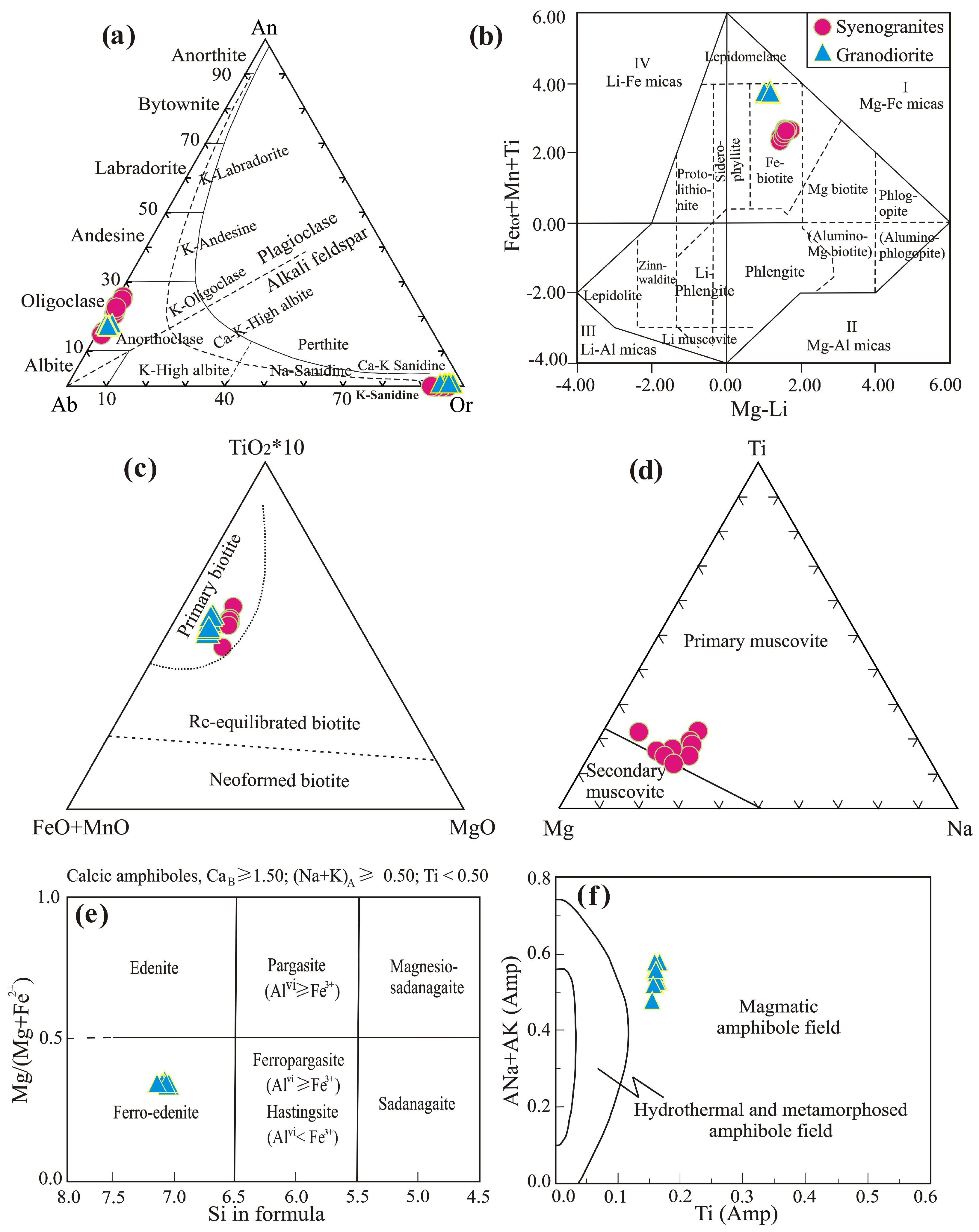

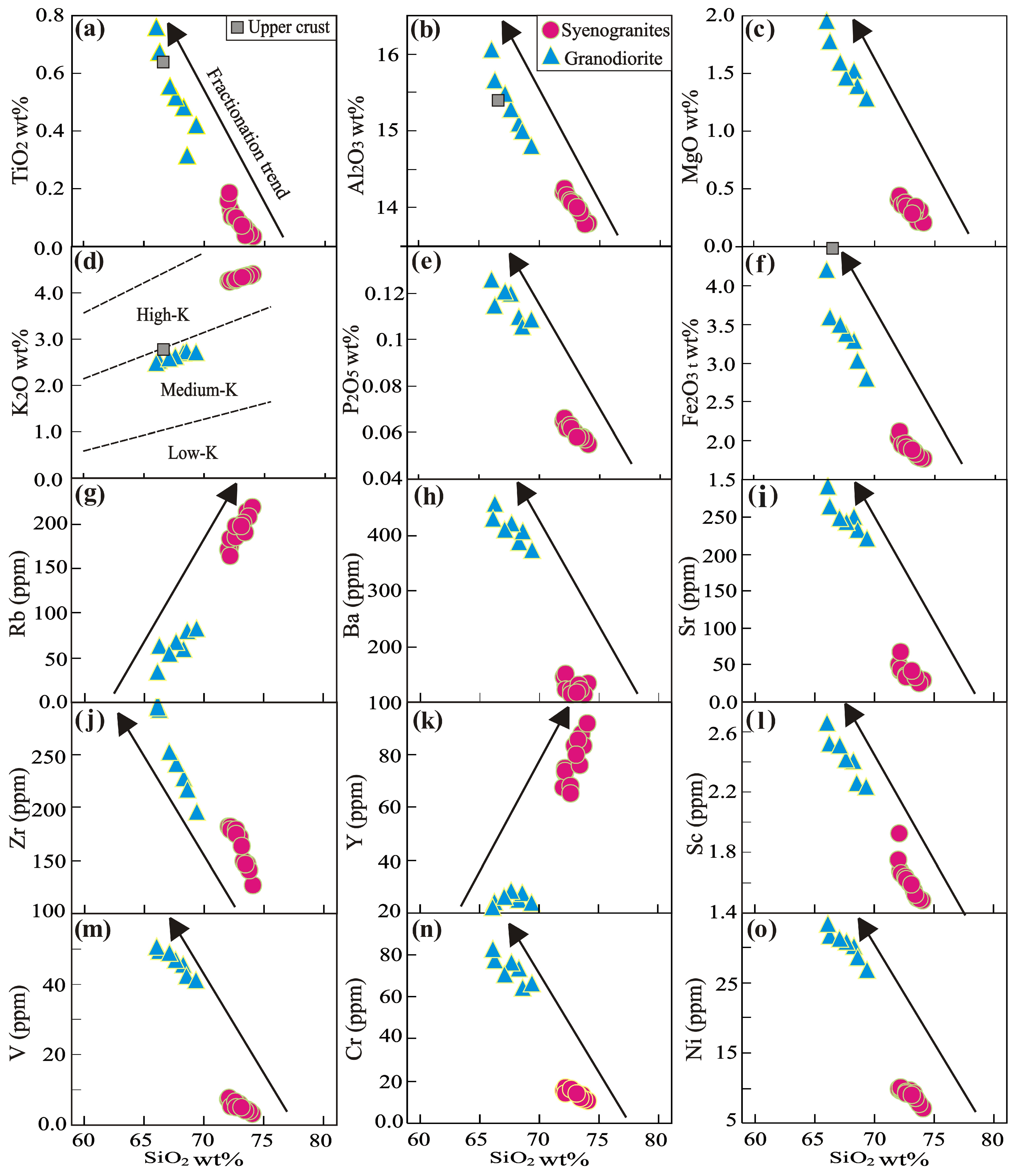
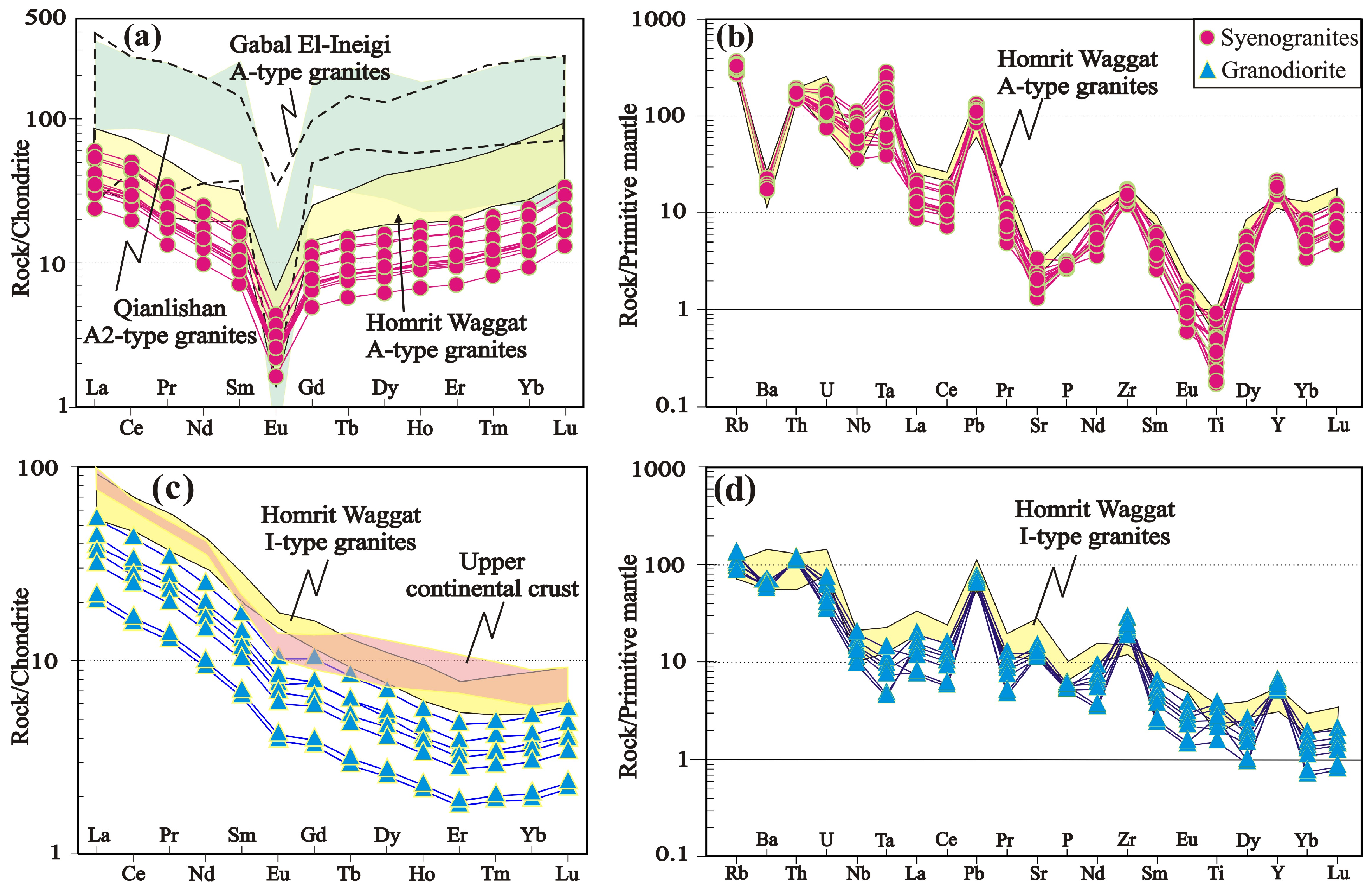
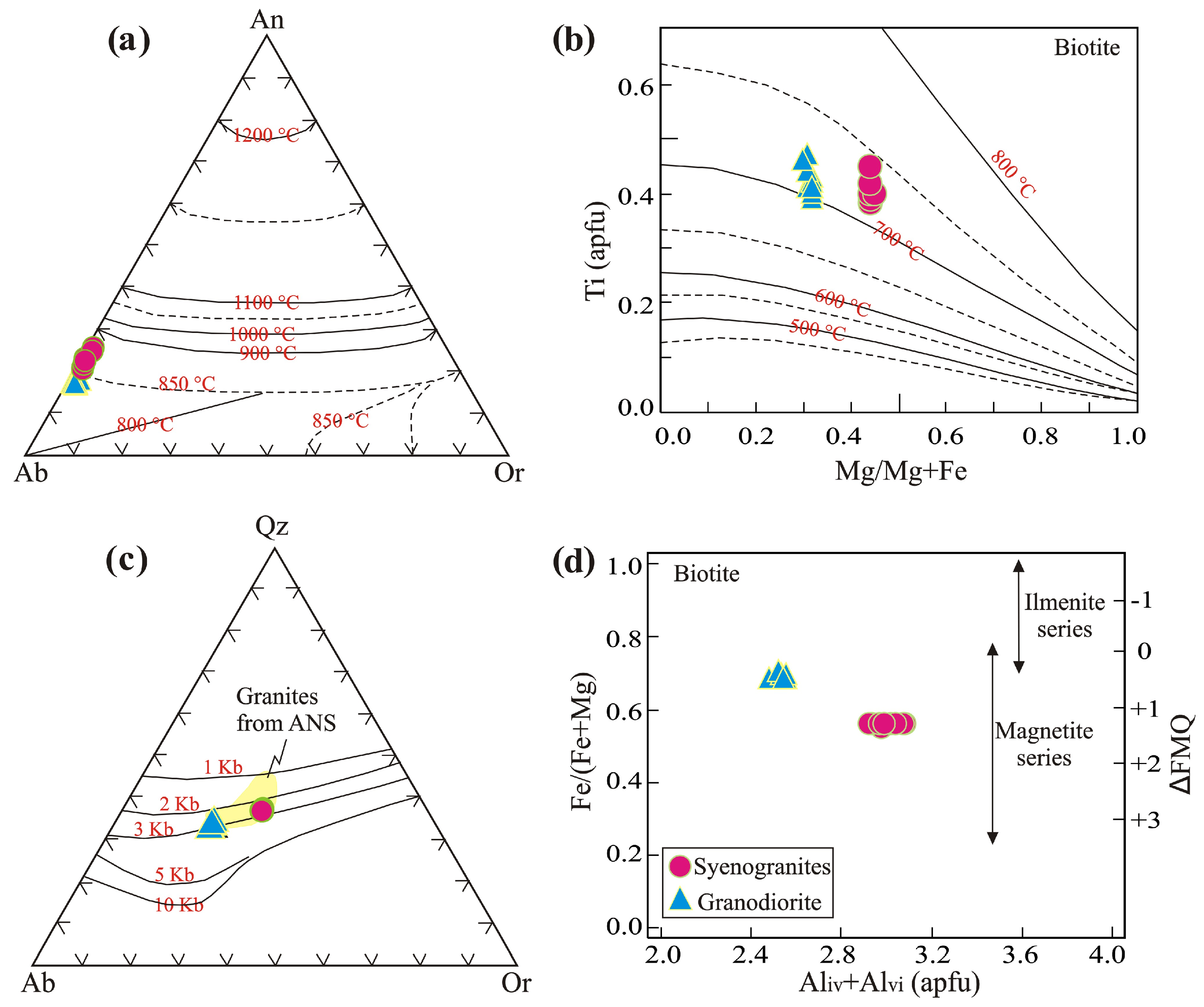
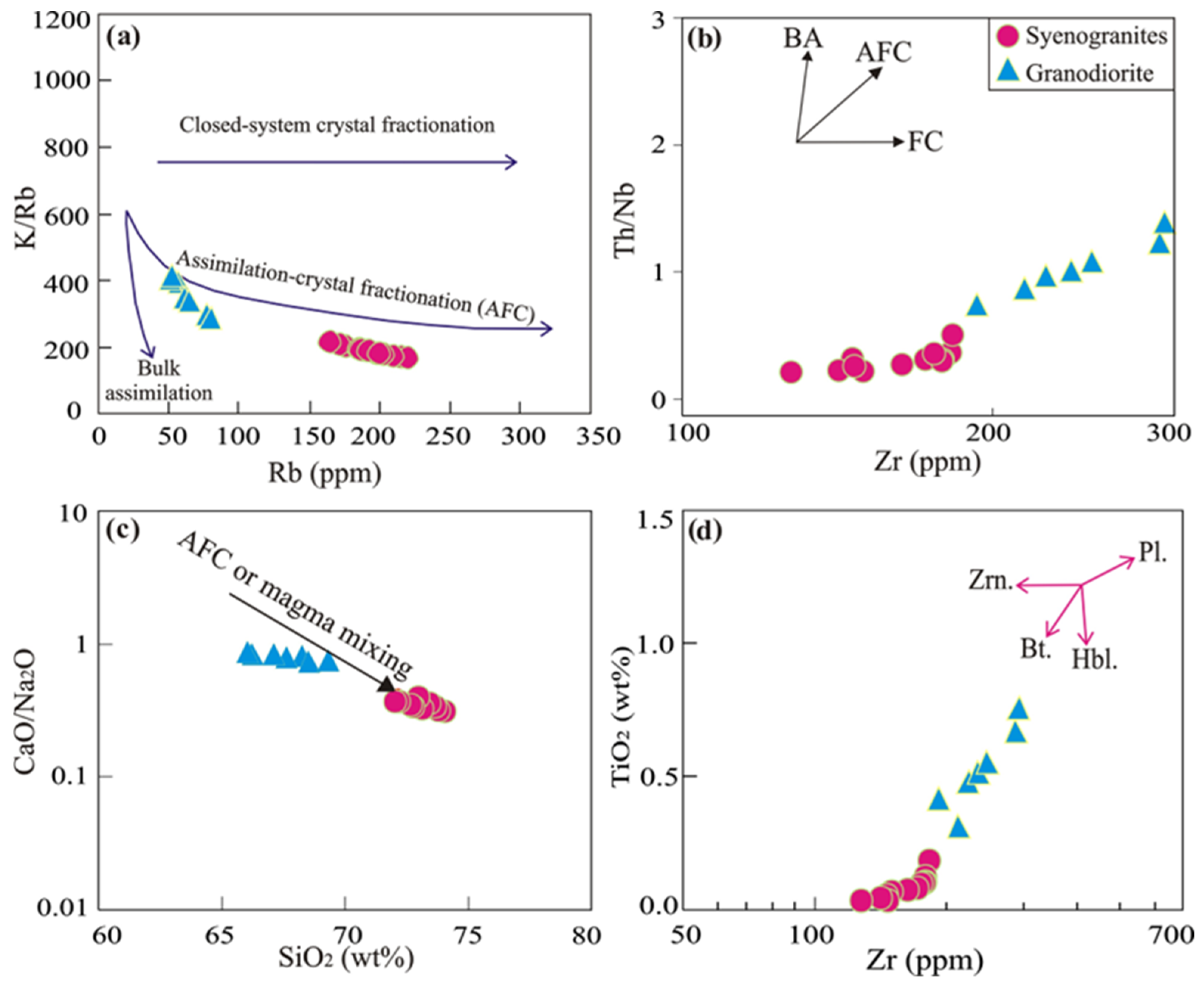
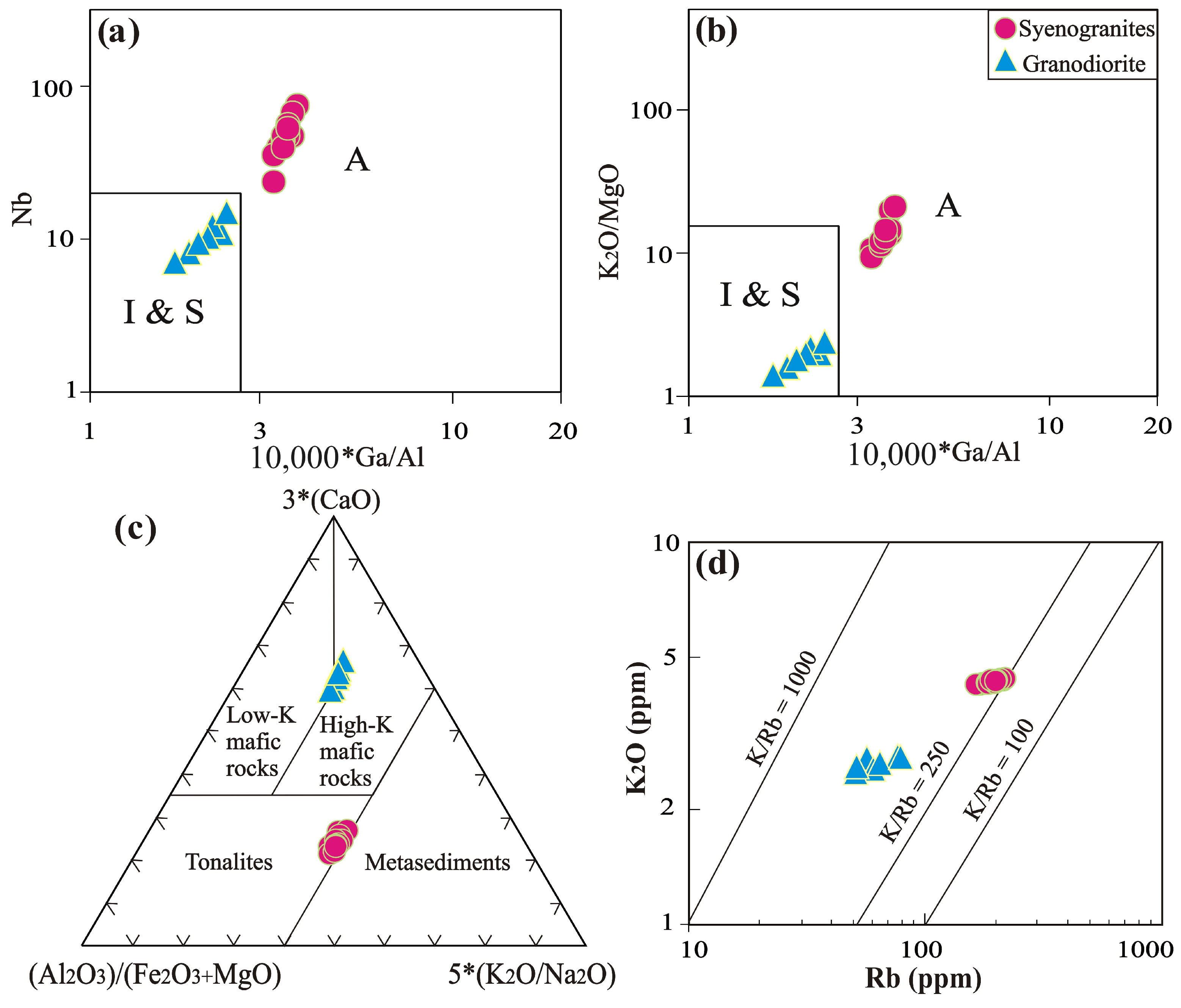

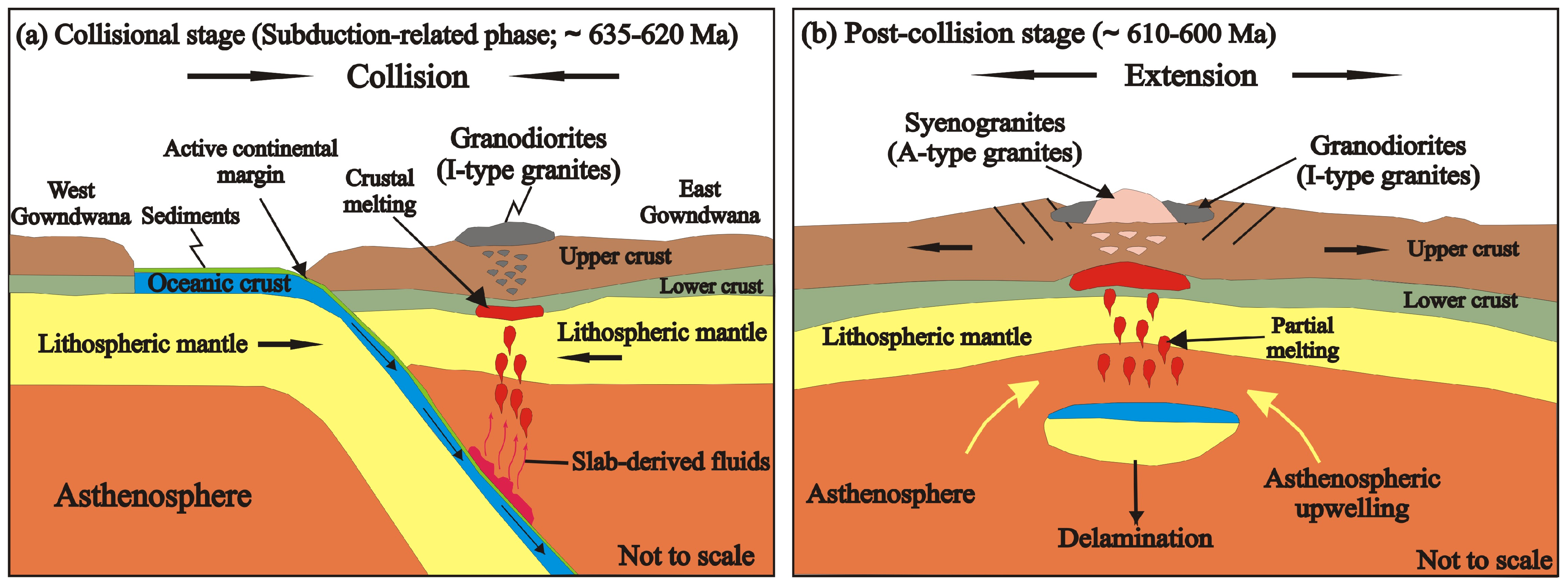
Disclaimer/Publisher’s Note: The statements, opinions and data contained in all publications are solely those of the individual author(s) and contributor(s) and not of MDPI and/or the editor(s). MDPI and/or the editor(s) disclaim responsibility for any injury to people or property resulting from any ideas, methods, instructions or products referred to in the content. |
© 2024 by the authors. Licensee MDPI, Basel, Switzerland. This article is an open access article distributed under the terms and conditions of the Creative Commons Attribution (CC BY) license (https://creativecommons.org/licenses/by/4.0/).
Share and Cite
El-Awady, A.; Sami, M.; Abart, R.; Fathy, D.; Farahat, E.S.; Ahmed, M.S.; Osman, H.; Ragab, A. Petrogenesis and Tectonic Evolution of I- and A-Type Granites of Mount Abu Kibash and Tulayah, Egypt: Evidence for Transition from Subduction to Post-Collision Magmatism. Minerals 2024, 14, 806. https://doi.org/10.3390/min14080806
El-Awady A, Sami M, Abart R, Fathy D, Farahat ES, Ahmed MS, Osman H, Ragab A. Petrogenesis and Tectonic Evolution of I- and A-Type Granites of Mount Abu Kibash and Tulayah, Egypt: Evidence for Transition from Subduction to Post-Collision Magmatism. Minerals. 2024; 14(8):806. https://doi.org/10.3390/min14080806
Chicago/Turabian StyleEl-Awady, Amr, Mabrouk Sami, Rainer Abart, Douaa Fathy, Esam S. Farahat, Mohamed S. Ahmed, Hassan Osman, and Azza Ragab. 2024. "Petrogenesis and Tectonic Evolution of I- and A-Type Granites of Mount Abu Kibash and Tulayah, Egypt: Evidence for Transition from Subduction to Post-Collision Magmatism" Minerals 14, no. 8: 806. https://doi.org/10.3390/min14080806





